Sear-Roasted Pork Tenderloin with Mustard Glaze
This post may contain affiliate links. Read my full disclosure policy.
Sear-roasted pork tenderloin with a sweet mustard glaze—your ticket to an effortlessly chic dinner, any night of the week or for special occasions.
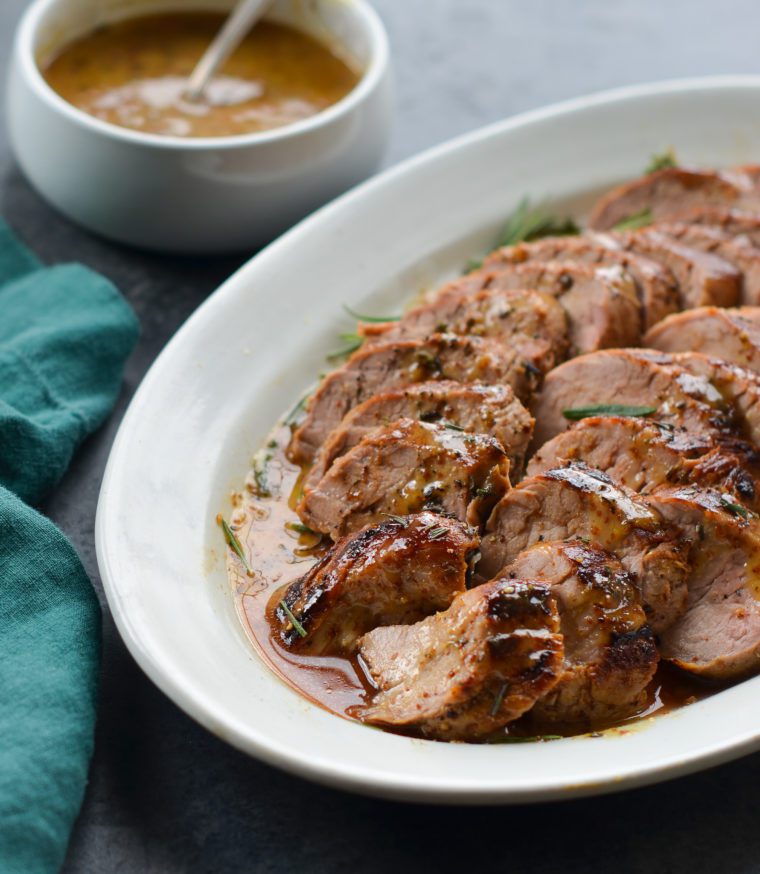
Adapted from cookbook author and food columnist Marian Burros’ 5-star mustard-glazed pork tenderloin, a gem first featured in The New York Times in 1989, this marinated and sear-roasted pork tenderloin makes a fancy weeknight dinner or special occasion roast. The marinade—a simple blend of mustard, brown sugar, rosemary, and sherry—not only infuses the tenderloin with a savory-sweet flavor but also serves as the foundation for a rich sauce.
The sauce is made using a technique known as “mounting.” This involves gradually whisking cold butter into the nearly completed sauce, allowing it to emulsify seamlessly. This method enriches the sauce, giving it with a glossy appearance and a luxuriously rich consistency. Pair the tenderloin with mashed sweet potatoes and French green beans for an effortlessly elegant meal.
Table of Contents
“Easy and oh-so-flavorful!! This looks difficult but comes together in a snap. Easy to marinate in the morning and cooks up in 30 minutes in the evening.”
What You’ll Need To Make Sear-Roasted Pork Tenderloin with Mustard Glaze
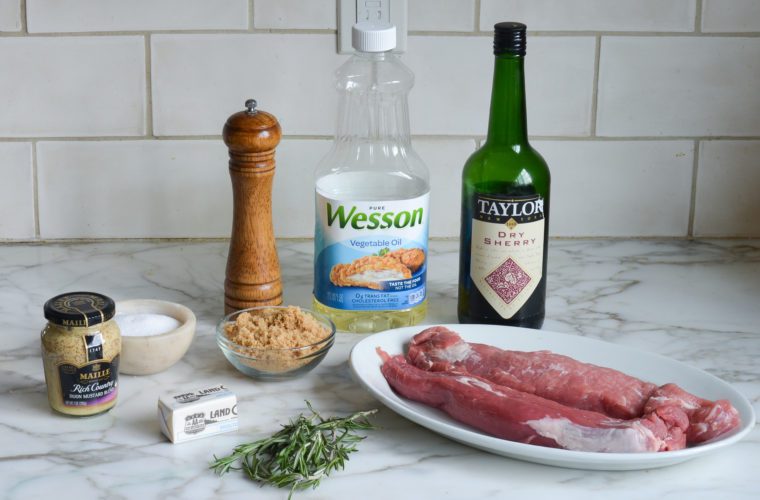
Pork tenderloin is a lean and tender boneless cut of meat that is best cooked using quick, high-heat methods, such as grilling or pan-searing. Each loin weighs about one pound, so you will need two of them.
Dry sherry is a type of fortified wine that is aged in barrels and has a rich, nutty flavor. In many cuisines, it is used to add depth and complexity to sauces, stews, and marinades. Be sure to use dry sherry rather than cooking sherry or sweet sherry. Cooking sherry is a lower-quality wine that is often heavily salted, and sweet sherry, while delicious as an after-dinner drink, is too sweet to be used in cooking.
Step-by-Step Instructions
In a medium bowl, combine the brown sugar, mustard, sherry, and rosemary.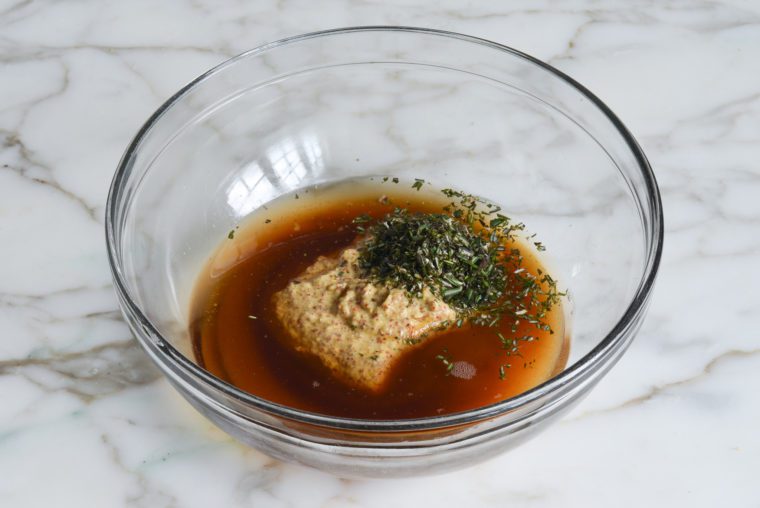
Whisk to combine.
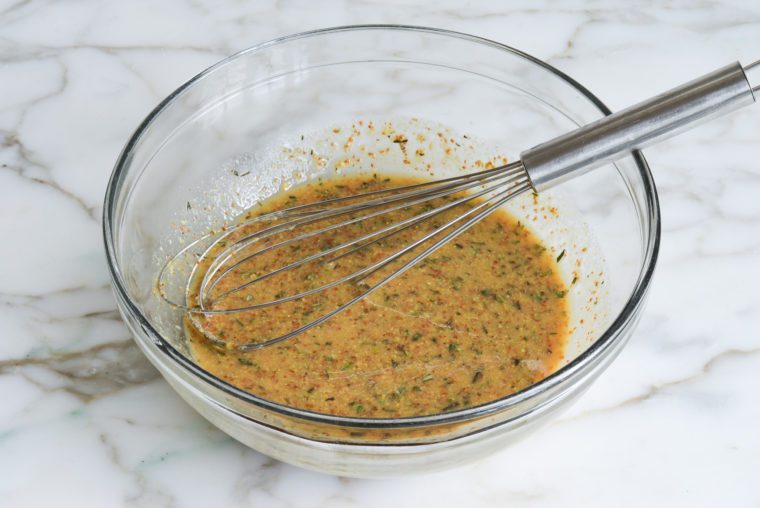
Place the tenderloins in a baking dish or bowl. Season all over with 1-1/4 teaspoons salt and pour about one-third of the marinade over top. Turn the tenderloins a few times to coat evenly with the marinade. Marinate for at least 1 hour or as long as overnight (the longer, the better). Cover the remaining marinade and refrigerate until ready to use (it will form the base of the sauce).
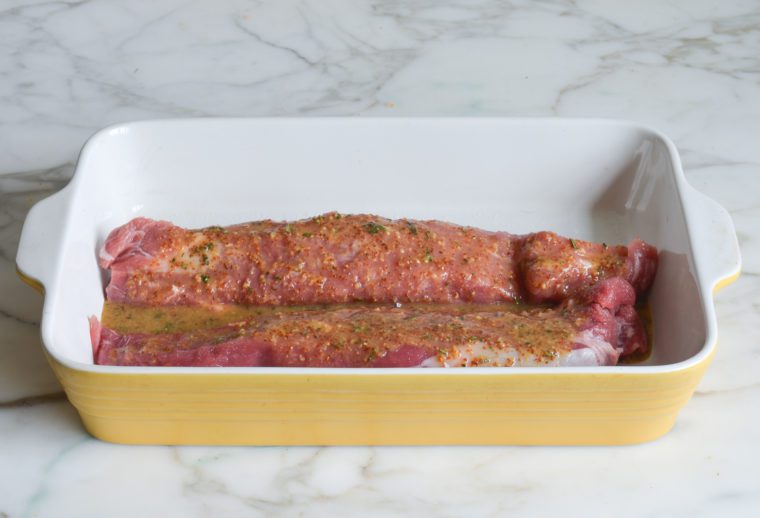
Heat the oil in a large cast iron or oven-safe skillet over medium-high heat and add both tenderloins.
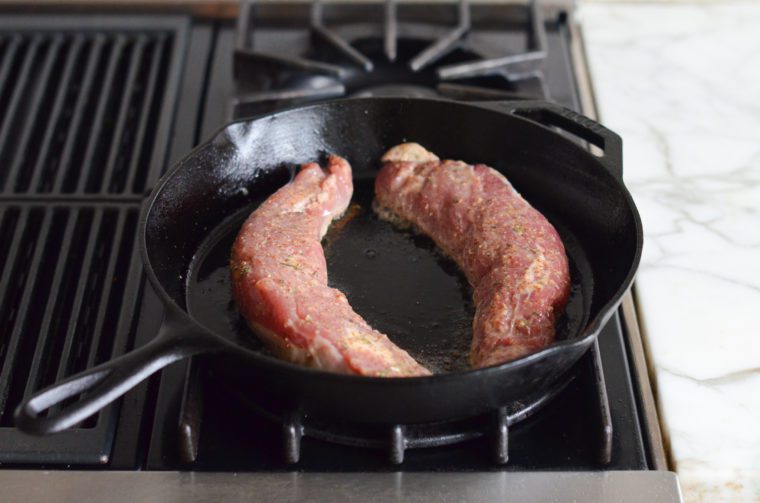
Sear on all sides until nicely browned, 6 to 8 minutes (don’t move the tenderloins around between turns; they will brown better if left alone).
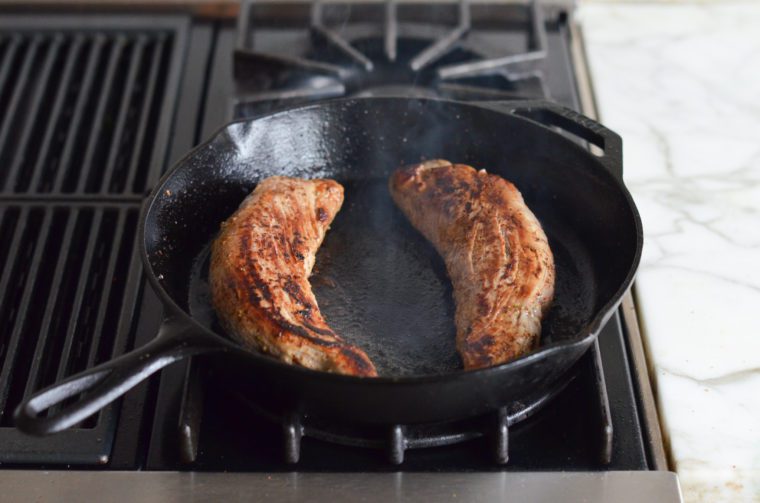
Transfer the skillet to a preheated 350°F-oven and cook until the pork registers about 140°F on an instant-read thermometer, 12 to 15 minutes. (To check for doneness without a thermometer, make a slit in the thickest part of the loin; the meat should be mostly white with a slight hint of pale pink, and the juices should run mostly clear.)
Meanwhile, pour the remaining marinade into a small skillet and bring to a gentle boil over medium-high heat. 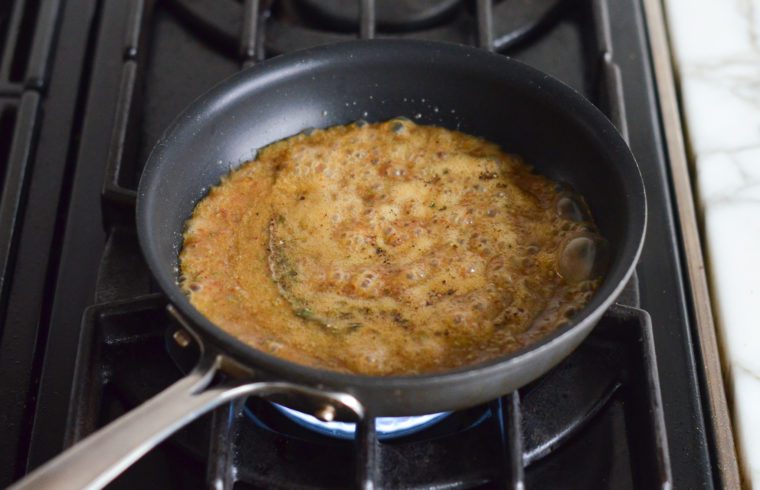
Remove the pan from the heat and, stirring constantly, incorporate the butter one piece at a time. Add 1/8 teaspoon salt and a few grinds of pepper. Taste and adjust seasoning if necessary.
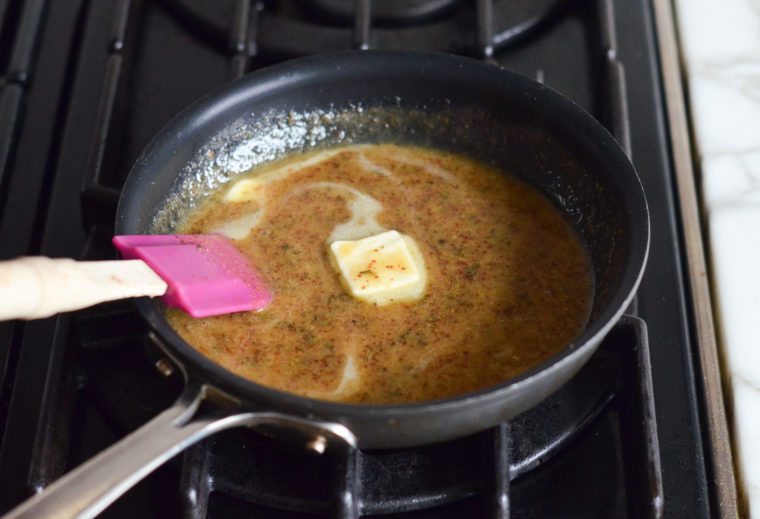
Remove the skillet from the oven and transfer the tenderloins to a cutting board. Tent with foil and let rest for about 10 minutes, then cut into 1/4- to 1/2-inch slices.
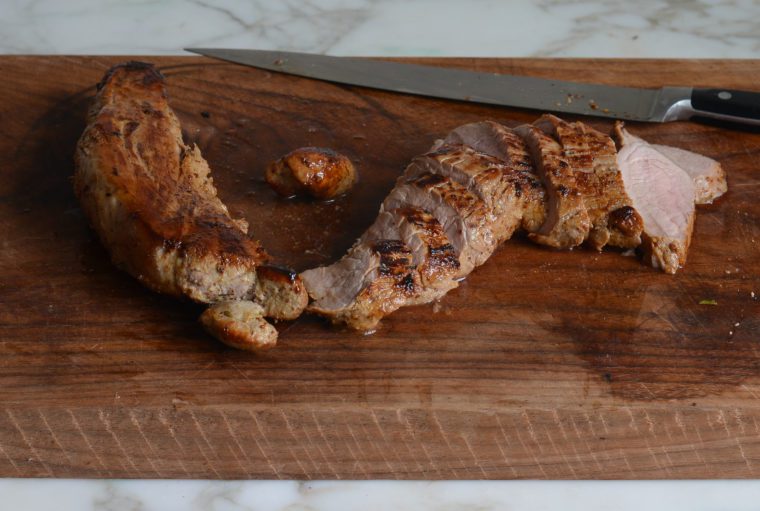
Arrange the sliced tenderloin on a platter and drizzle with a bit of the sauce; pass the remaining sauce at the table.

Frequently Asked Questions
Pork tenderloin is a lean, slender cut typically weighing between 1 and 1.5 pounds. Renowned for its tenderness, it’s best prepared using quick, high-heat cooking methods like grilling, pan-searing, or roasting, with careful attention to avoid drying out due to its low fat content. In contrast, the pork loin roast is a larger and thicker cut, often weighing 2 to 5 pounds or more. Its higher fat content lends a richer flavor and makes it ideal for slower cooking methods such as roasting or braising.
Pork tenderloin can often turn out dry due to overcooking, which is a common issue given its lean nature. To prevent overcooking, it’s best to cook pork tenderloin just until it reaches 140°F and then allow it to rest for a few minutes to rise to the safe internal temperature of 145°F before slicing. This rest period also lets the juices redistribute throughout the meat. Additionally, cooking methods that involve searing the meat to lock in juices and then finishing in the oven at a moderate temperature can also help maintain tenderness.
Yes, pork is safe to eat even if it’s slightly pink, as long as it reaches the USDA’s recommended safe internal temperature of 145°F (63°C). You can remove the pork from the heat when it reaches 140°F (60°C), and let it rest for about 5 minutes. During this rest period, the internal temperature will continue to rise, or “carry over cook,” to the safe temperature. I recommend using a meat thermometer to accurately check the internal temperature.
You May Also Like
“I made this for Christmas Eve dinner for 8 and doubled the recipe. It’s Christmas Day and my family is still talking about last night’s meal.”
Sear-Roasted Pork Tenderloin with Mustard Glaze
Sear-roasted pork tenderloin with a sweet mustard glaze—your ticket to an effortlessly chic dinner, any night of the week or for special occasions.
Ingredients
- 2 pork tenderloins (1¾ to 2 lbs total)
- ½ cup (packed) light brown sugar
- ½ cup grainy Dijon mustard (such as Maille Rich Country Dijon Mustard Blend or Grey Poupon Country Dijon)
- ½ cup dry sherry
- 1 tablespoon chopped fresh rosemary
- Salt
- 1 tablespoon vegetable oil, for cooking
- Freshly ground black pepper
- 5 tablespoons unsalted butter, cut into 5 pieces
Instructions
- Pat the tenderloins dry with paper towels.
- In a medium bowl, whisk together the brown sugar, mustard, sherry, and rosemary.
- Place the tenderloins in a baking dish or bowl. Season all over with 1¼ teaspoons salt and pour about one-third of the marinade over top. Turn the tenderloins a few times to coat evenly with the marinade. Marinate for at least 1 hour or as long as overnight (the longer, the better). Cover the remaining marinade and refrigerate until ready to use (it will form the base of the sauce).
- Preheat the oven to 350°F and set an oven rack in the middle position.
- Heat the oil in a large cast iron or oven-safe skillet over medium-high heat (see note below if you don't have one of these pans). Add both tenderloins and sear on all sides until nicely browned, 6 to 8 minutes (don't move the tenderloins around between turns; they will brown better if left alone). Transfer the skillet to the oven and cook until the pork registers about 140°F on an instant-read thermometer, 12 to 15 minutes. (To check for doneness without a thermometer, make a slit in the thickest part of the loin; the meat should be mostly white with a slight hint of pale pink, and the juices should run mostly clear.)
- Remove the skillet from the oven and immediately place an oven mitt or dishtowel over the handle to remind yourself that it is hot (it is easy to forget and burn yourself!). Transfer the tenderloins to a cutting board. Tent with foil and let rest for about 10 minutes, then cut into ¼- to ½-inch slices.
- Meanwhile, pour the remaining marinade into a small skillet and bring to a gentle boil over medium-high heat. Remove the pan from the heat and, stirring constantly, incorporate the butter one piece at a time. Add ⅛ teaspoon salt and a few grinds of pepper. Taste and adjust seasoning if necessary. Arrange the sliced tenderloin on a platter and drizzle with a bit of the sauce; pass the remaining sauce at the table.
- Note: If you don't have an oven-proof skillet, transfer the pork to a foil-lined sheet pan after searing. (The foil is just for easy cleanup.) You may need to add a few minutes to the baking time.
- Note: The nutritional information includes all of the ingredients for the marinade, so one serving is likely significantly lower in calories and fat than the numbers below.
Pair with
Nutrition Information
Powered by ![]()
- Per serving (6 servings)
- Calories: 336
- Fat: 17 g
- Saturated fat: 8 g
- Carbohydrates: 14 g
- Sugar: 12 g
- Fiber: 1 g
- Protein: 28 g
- Sodium: 438 mg
- Cholesterol: 111 mg
This website is written and produced for informational purposes only. I am not a certified nutritionist and the nutritional data on this site has not been evaluated or approved by a nutritionist or the Food and Drug Administration. Nutritional information is offered as a courtesy and should not be construed as a guarantee. The data is calculated through an online nutritional calculator, Edamam.com. Although I do my best to provide accurate nutritional information, these figures should be considered estimates only. Varying factors such as product types or brands purchased, natural fluctuations in fresh produce, and the way ingredients are processed change the effective nutritional information in any given recipe. Furthermore, different online calculators provide different results depending on their own nutrition fact sources and algorithms. To obtain the most accurate nutritional information in a given recipe, you should calculate the nutritional information with the actual ingredients used in your recipe, using your preferred nutrition calculator.

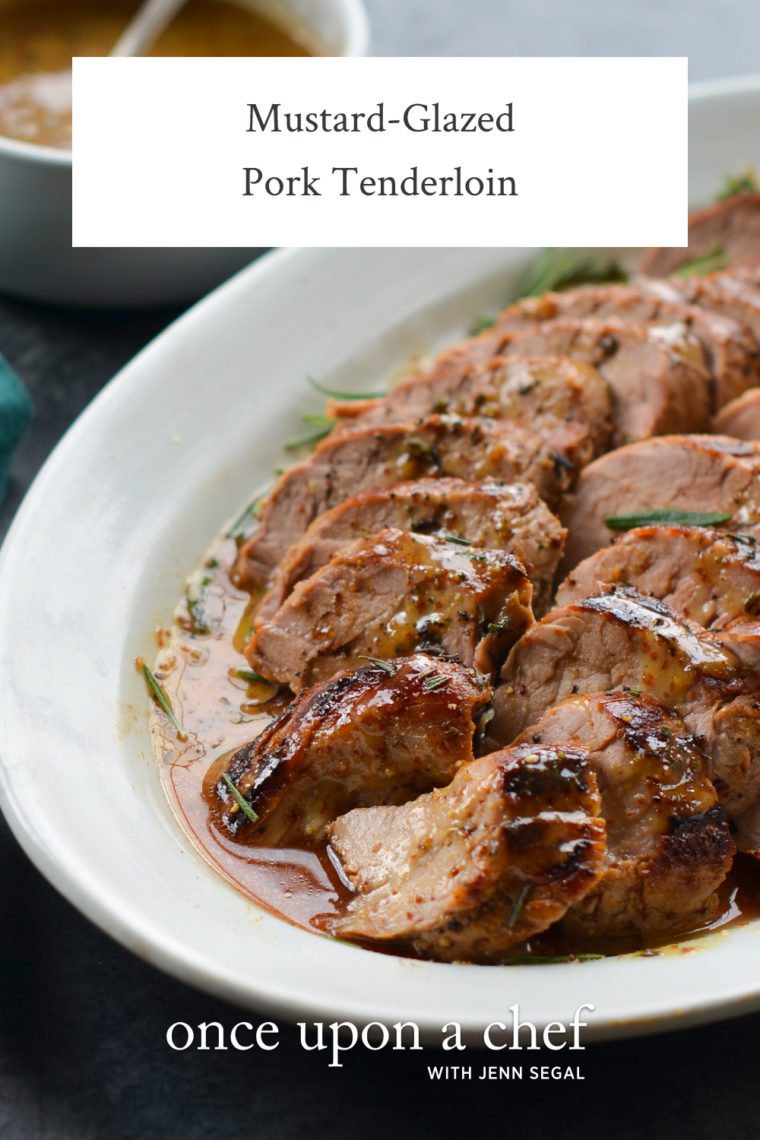
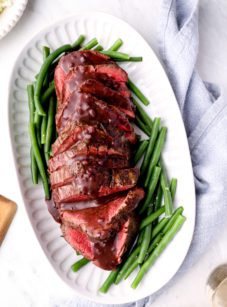
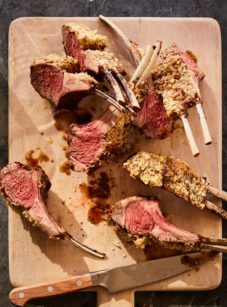

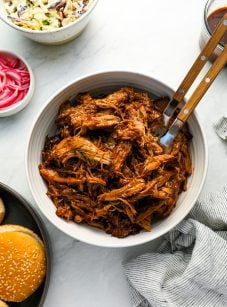
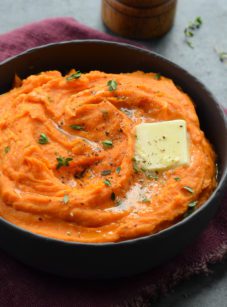

I’ve been making recipes from this site for many years and as always this one is another keeper. I marinated the tenderloins for three hours and they turned out perfectly. My husband is not a big eater and he ate one whole tenderloin! Served with cilantro and lime basmati rice and steamed broccoli. Delicious.
We made this last night for some friends and it was delicious. We paired it with the Mashed Sweet Potatoes and Caesar Salad. I can’t say enough good things about our whole meal.
Pork loin very tender, easy to make and tasty marinate.
…to clarify – marinating overnight (not a full day in advance)…. Thanks!
Another winning recipe, Jenn! Used one ea. 1-pound tenderloin for my husband and me… Made for lunch for 2-days. But in that time, the sauce flavor really coalesced nicely… as in “spoon-licking good”. In fact, next time we make it, we might make the sauce 2-days early, marinating 1-day in advance of cooking. Served with Brussels Sprouts – delicious!!!
Delicious! Tender, slightly pink pork tenderloin cooked to perfection! The sauce makes the dish. Served it with roasted asparagus and sweet potatoes. Adding it to favorite recipes along with your chicken Marsala.
Hi Jenn. This web site and your cookbook are my go-to resources (I took up cooking after retirement). This looks like a great recipe. A question. Would a medium solera sherry work or should I stick with dry?
Hi Mike, thanks for your nice words — so glad you like the recipes and have more time to spend in the kitchen! For the best results, I’d stick with dry sherry here. Hope you enjoy!
Absolutely delicious!
Wow, was this so delicious!! I fudged a little and combined spicy and yellow mustards and dried rosemary, because I didn’t have the grain mustard or fresh rosemary on hand. It still was really tasty and the gravy is pure heaven and so glossy with all the butter. The sherry makes it! Thank you for a lovely recipe!
Do you think this would work with a large pork loin roast? With adjusted oven time to bring to proper temperature
Hi Tracy, I do think it would work, but it won’t be as tender. I’d love to know how it turns out if you try it.